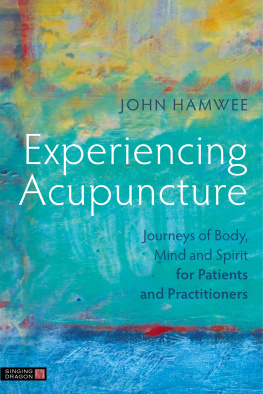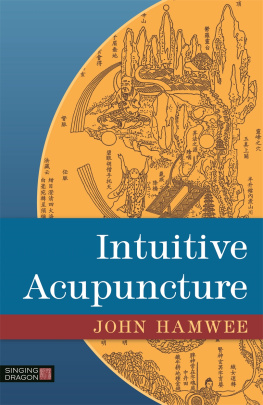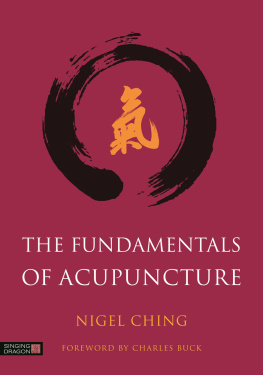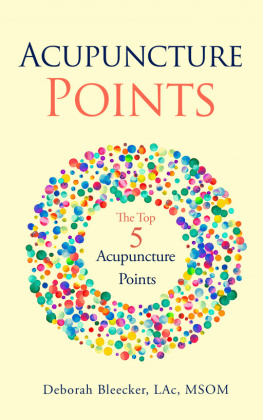John Hamwee - Experiencing Acupuncture
Here you can read online John Hamwee - Experiencing Acupuncture full text of the book (entire story) in english for free. Download pdf and epub, get meaning, cover and reviews about this ebook. year: 2020, publisher: Jessica Kingsley Publishers, genre: Detective and thriller. Description of the work, (preface) as well as reviews are available. Best literature library LitArk.com created for fans of good reading and offers a wide selection of genres:
Romance novel
Science fiction
Adventure
Detective
Science
History
Home and family
Prose
Art
Politics
Computer
Non-fiction
Religion
Business
Children
Humor
Choose a favorite category and find really read worthwhile books. Enjoy immersion in the world of imagination, feel the emotions of the characters or learn something new for yourself, make an fascinating discovery.
- Book:Experiencing Acupuncture
- Author:
- Publisher:Jessica Kingsley Publishers
- Genre:
- Year:2020
- Rating:4 / 5
- Favourites:Add to favourites
- Your mark:
- 80
- 1
- 2
- 3
- 4
- 5
Experiencing Acupuncture: summary, description and annotation
We offer to read an annotation, description, summary or preface (depends on what the author of the book "Experiencing Acupuncture" wrote himself). If you haven't found the necessary information about the book — write in the comments, we will try to find it.
Experiencing Acupuncture — read online for free the complete book (whole text) full work
Below is the text of the book, divided by pages. System saving the place of the last page read, allows you to conveniently read the book "Experiencing Acupuncture" online for free, without having to search again every time where you left off. Put a bookmark, and you can go to the page where you finished reading at any time.
Font size:
Interval:
Bookmark:

Experiencing
Acupuncture
Journeys of Body, Mind and Spirit
for Patients and Practitioners
John Hamwee

All the accounts of treatment in this book come directly from my experience in the treatment room. I have had to protect the privacy of my patients and the confidentiality of our work together, so I have concealed their identities in various ways changing gender, age and background details and sometimes conflating the experiences of two or three of them into one story. In two instances, where full concealment was not possible, the patients read the accounts and gave consent to them being published. But everything I report really did happen, and all the stories are true.
The accounts are grouped into three sets of three, as there are common themes in the experience of treating the patients in each group, but the accounts can be read in any order. And there is no technical information in the book which would come as a surprise to someone who has ever had acupuncture, and very little which would be puzzling to any other reader. Practitioners, however, may be interested in some more technical detail and so the appendix gives a brief account of my reasons for doing specific treatments and the points I used in them.
Two experiences of treatment opened my eyes to a new way of seeing the world. One was as a patient. The first time I had acupuncture was for some minor ailment. It improved, but what astonished me was that my life-long asthma disappeared. My acupuncturist seemed unsurprised: If you get better then everything will get better, she commented. It struck me then as simple common sense, but at the same time it was profoundly radical for it was the opposite of everything I had been told about illness and I had been ill a lot as a child.
The other experience was soon after I had qualified as an acupuncturist and zero balancer. A woman told me that she had broken her left arm in a car crash two years earlier. According to the X rays the fracture had healed perfectly and her doctors could find no evidence of nerve damage, and yet she could hardly use her left hand. It moved as directed by her brain, if a little slowly, but it was not strong enough to allow her to pick up a cup or to drive a car. I felt along the arm and it was remarkable. Above the site of the fracture it felt warm and alive, but below it was cold and dead.
Fortunately I had been taught by Dr Fritz Smith, a master practitioner with an unusual set of qualifications, for he is a Western medical doctor, osteopath and acupuncturist. Before I met him I already knew that there are coherent and organised flows of energy in the body, flows which were mapped thousands of years ago and which have been used by practitioners in the East ever since; what I didnt know was that with a little practice it is possible to feel these flows and to sense if they have been disturbed or interrupted. I could tell that the flow down this womans arm had been broken along with the bone, so her hand was not receiving the energy it needed to work properly. Could I re-establish that flow?
I had never done it before but, relying on the methods Dr Smith had taught me, it turned out to be easy, and within a few minutes her hand started to re-gain its strength. I was more surprised than the patient. It is one thing to know the theory; it is another to see it work so quickly and conclusively.
These two experiences showed me the enormous scope of a system of medicine which seeks to heal through changing the state of a patients energy. One treatment was for the chronic weakness of an organ, the other for a failure of a limb; one condition was not specifically treated at all, while the other was treated very locally and deliberately; one kind of treatment I could learn from the ancient texts, the other only from a master. But what they all had in common is that they showed me that if the energy of the body is restored to at least something approaching its natural flows, its rhythms and vitality, then healing is possible.
They also stimulated in me an interest in the experience of treatment. Books about acupuncture usually set out the theory and explain the concepts used in diagnosis, while some also describe various techniques as well. This book is completely different. It tries to capture what acupuncture is like. It does so through accounts of the treatment of a few of my patients stories of the journeys they undertook in order to get well. Remarkable, sometimes inspiring stories of healing; stories too of the doubts and difficulties I often had in treating them; and stories of failures as well.
I hope that these accounts will help those who are considering treatment for the first time and want to know what they might be letting themselves in for. And those who are already having acupuncture may have wondered, as one of my patients once wondered out loud: What are you doing as you think about how to treat me? Are you evaluating me in some way, judging me, trying to work out the cause of my illness? Does it matter that we get on well? And why do you write so many notes? The accounts should also help patients to make the most of their treatments. They show that, contrary to popular belief, acupuncture has much more to offer than pain relief or an improvement in symptoms, and they make it clear that healing often comes about through a particular kind of collaboration between patient and practitioner.
I hope that these accounts have something to offer to acupuncturists as well. I often think how much I would like to be a fly on the wall of someone elses treatment room and see how he or she works with a patient who, for example, comes with an enormous list of symptoms, or who only gives the briefest of answers to questions, or who doesnt respond well to treatment in spite of a convincing diagnosis and treatment strategy all common experiences for me. I hope that my frank accounts of how I tried to work with the uncertainties and anxieties we all face may help other acupuncturists cope with their own.
So the book gives nine full accounts of acupuncture treatments, each one showing what the experience was like as a patient and I travelled together along the sometimes rocky road towards health. A few of the patients had physical pain or dysfunction; some had mental or emotional pain too; and treatment for others was really about reviving their spirit. The journey was different each time, for as a consultant neurologist points out, Everybodys experience of illness is their own A persons personality and their life experience moulds the clinical presentation, the response and the outcome of any brush with illness (OSullivan 2015, p.21). And the author might have added another thing which moulds the outcome the singular nature of the relationship between the patient and practitioner.
All of which raises a really interesting issue because medical education and textbooks, whether Western or Eastern, depend on generalisations; that is, on classifying types of illnesses and then types of treatments appropriate to each. There are the signs and symptoms of asthma or Crohns disease, for example, in Western medicine and of Liver Qi Stagnation or Blood deficiency in Eastern, and they apply regardless of the individual differences of individual patients. So how to bridge the gap between these necessary generalisations and the equally necessary unique responses to the particular patient?
Font size:
Interval:
Bookmark:
Similar books «Experiencing Acupuncture»
Look at similar books to Experiencing Acupuncture. We have selected literature similar in name and meaning in the hope of providing readers with more options to find new, interesting, not yet read works.
Discussion, reviews of the book Experiencing Acupuncture and just readers' own opinions. Leave your comments, write what you think about the work, its meaning or the main characters. Specify what exactly you liked and what you didn't like, and why you think so.




![John Urbanski D.C. - Acupuncture Meridian Point Locations Atlas [fixed Toc and Links]](/uploads/posts/book/281557/thumbs/john-urbanski-d-c-acupuncture-meridian-point.jpg)



